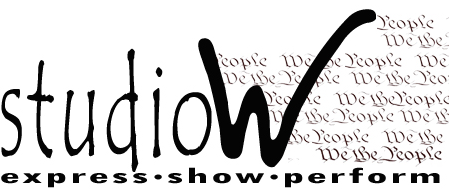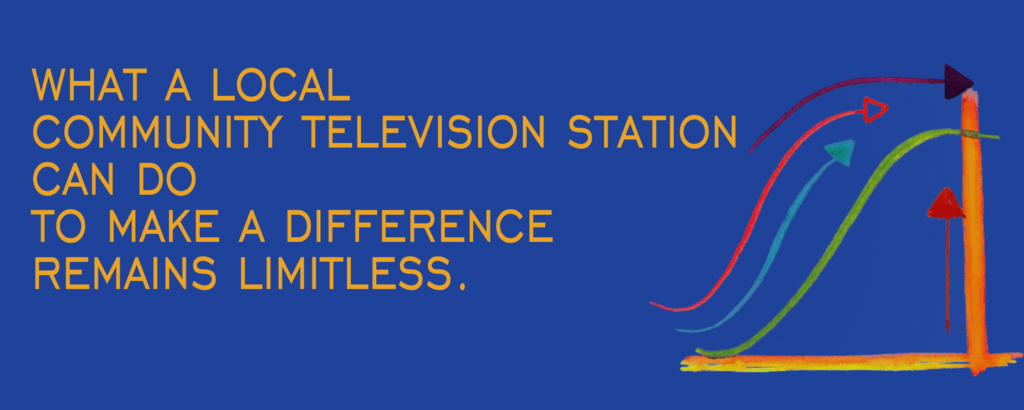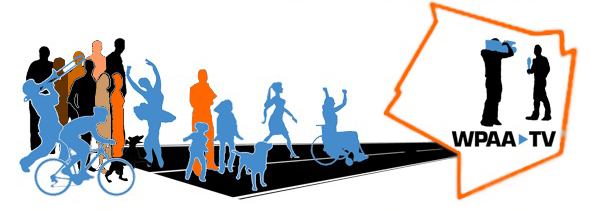Our situation: End-of-Life for Cable TV
Our core function is ‘Make TV’ which is supporting the production of digital media content by, or for, the people for hyperlocal cable TV distribution. Providing this media agency to nonprofessionals is one component of P.E.G.: Public Access Community TV. Is it still a needed thing? For how long? What is Next?
Since 2005 media distribution options for content produced by people has expanded beyond community TV. In 2009, one of the most profitable YouTubers was homegrown at WPAA. The availability of social media platforms has helped, and hurt, the evolution of ‘equitable’ access to production & distribution resources for the people. Most users assume that social media platforms are free and free speech friendly. They certainly can be used that way but that’s not their purpose. Social media platforms are private company owned. They are not bound by the First Amendment. They can moderate, deny and inequitable influence content visability without violating users’ speech. Their primary focus is monetization. They will constantly encourage you to pay them to ‘promote’ your content.
For the most recent Supreme Court-level discussion on Public-Access as a Free Speech platform, check out this 2019 SCOTUSblog post.
How do you view Community Media?
For decades, regulatory restrictions limited the use of Cable TV public-access funding to content created for TV distribution. PURA affirmed in a Q&A (10.28.24) that PEGPETIA grant funds ‘… can be now be used to distribute programming on other platforms to increase viewer access to our ‘public benefit’ existence. It is conditional. The content must still be played on TV. There is an annual request and award process for capital funding. Awards are not guaranteed. Ideally, they are sufficient to cover bandwidth, website domain, and other public distribution expenses.
For nearly a decade, a local company, Discover Video, enabled WPAA-TV to provide on-demand internet access to our locally produced content. This tech donation kept us at the forefront of innovation. More importantly, it expanded access to a broader population. We are grateful for years of free support; however, underwriting has ceased. Now we provide this extended distribution as a customer. We submit the cost in PEGPETIA applications.
We do more than TV distribution. Our channel is simulcast in HD to the internet at wpaa.tv/watch 24/7. Videos with evergreen content are reformatted for Podcast and are available as As Told Here: WPAA-TV. Content produced by WPAA-TV is distributed on YouTube @WpaaTV. Short-form digital content is posted on social-media. Local producers use YouTube Channels to share their content. It belongs to them.
Our cable TV affiliation could disappear
Since 2012, our subscriber fee income has been in steady decline. It will continue to decline without statutory reform. It is intrinsically linked to cable TV subscriptions. Federal and State laws and regulations are anchored in archaic technical ‘cable TV’ language.
Wallingford (and the Branford Comcast franchise towns receiving a percentage of Wallingford subscriber fees) benefited from the AT&T and Frontier cable TV deployment because our town was their initial hub. In 2012, WPAA-TV received nearly $27,000 in revenue from this market competitor to Comcast. Our 2024 income from Frontier is projected to be $3000. The most recent quarterly payment for year-ending 2024 was under $1,000. Frontier no longer markets cable TV. They have partnered with AT&T to provide satellite using the last mile of fiber from the same poles. Instead of satellite dishes on the roof, people have a small converter box and remote control very much like cable TV subscribers. The result is fees are not paid for using the poles. Satellite TV does not include local content. There is no public benefit.
In summary, there are now several noncable users of the public rights-of-way who have no public benefit requirements for the use of ‘telephone’ poles along our streets. The landscape for providers and viewers is changing. Comcast is considering divesting to Verizon. Frontier has partnered with satellite. They are incentivizing cable TV customers to leave. There is significant and unpredictable change. Community TV is being cancelled by Fortune 500 companies have rebranded.
The Community TV Study Docket #22-06-23 affirmed
- The current statutory framework, … is not designed for this new landscape… Under current statutes, cable companies must provide community access…
- re-imagining the statutory framework for community access will require a balancing of interests.
- there is no consensus among community providers who have different ‘In The Public Interest’ nonprofit models
- there is consensus among the 10 cable providers in CT that there is no need for them to have this public benefit obligation.
At the opening of the 2025 CT legislative session, 555 Bills had been drafted. By the bill filing date a few friends of community TV drafted transitional funding Bills for community TV: House Bills 5833, 5837,5848 Rep. Mushinsky submitted HB5848
If not TV, what?
In the event that our TV affiliation becomes mute: Is it the intention of WPAA-TV to remain an art, humanities & culture organization? Would this include retaining an internet channel? If yes, should we embody the original intent of the public access television as a local democracy movement providing agency to individuals, civic groups, and non-profits at no or low cost?
This will be reviewed in the Board’s next strategic planning session.
ACTIONS To-date
Our mission statement is used in grants and public profiles including our website. In 2024, the mission statement was modified to be more ‘place-based’. Our mission image was colorized to represent inclusion. The image and brand tags are ‘TV’ and Wallingford-centric.
Mission: To provide a brave, safe, and creative space for a diversity of expression from within our community. Make TV |Watch TV|More Than TV – Join In. Discover what you did not know you needed.
(2024) Wallingford Public Access Association (WPAA), d/b/a WPAA-TV and Community Media Center facilitates the production of digital media by people and organizations and distributes the content as community access television. Our doors are open to all on a 1st come, 1st serve basis.
Goal: To empower the people of Wallingford and beyond to meet their communication needs, as they define them, by facilitating digital media creation and managing its public distribution. The use of WPAA-TV digital media tools and studioW stage can help inform, connect, and build community through the production of ideas, opinions, stories, news, information, or performance. Our tools & stage yield more than videos when U watch and share. Unity begins with U.
Community TV, an experiment in democracy, engages people in ‘Good Trouble’. This experiment has at its core, the idea that ‘We The People’ must sustain our democracy. What we do together is anchored in valuing free speech, individual expression, inclusion, and diversity.
WPAA-TV is an award-winning volunteer-run Art, Culture, and Humanities organization that focuses on #SocialActionArt: We use art to uplift, inform, or inspire. We believe performance speech is the richest kind of free speech.
Our core program is ‘Make TV’. However, WPAA is #MoreThanTV. It is a place-based adaptive space for community meetings, theater, art exhibits, and special programs like film initiatives and internships of various kinds. We also bring creators together in response to our community’s needs for civic & digital literacy and well-being. We collaborate with other local nonprofits to advance their missions.
WPAA supports, or produces, a limited number of ‘Mission Continues’ projects. These projects must have the potential for community impact for the underserved and/or youth.
Our 2024 Annual Report theme: ‘Democracy is a Creative Practice’.
Examining the Creative Practice
Story and conversation are the cornerstones of our nonprofit business. TV is merely a distribution platform. Story crafting, people gathering, and uplifting voices are the practice.
Fundamental to the practice of Making TV: Story
Before technology of any kind, there was story. Stories bring people together to entertain, learn, or take action. They play a crucial role in fostering connection, building shared identity, transmitting cultural knowledge, promoting empathy, and creating a sense of belonging. Storytelling leads to engagement by fostering opportunities for sharing experiences, perspectives, and values. Ultimately bonds are strengthening within a community. Stories can provide a common language for discussing complex issues and fostering open communication within a community.
Public Access content is predominantly comprised of recorded conversations, performances, and event coverage including spiritual services. All include some element of ‘story’.
Outside of the community TV sphere, several nonprofits are anchored in the Impact of Story. Change The Story Change The World sixdegrees.org StoryCorp Other nonprofits rely on powerful narratives to communicate their cause and inspire action. Recent misinformation research suggests the two biggest action-motivators are fear and inspiration. Some provide marketing support to nonprofits as a nonprofit MissionStory The StoryTelling Nonprofit or as business consultants. Some are shutting down. Socialbrite since 2011
For Strategic Consideration: Focus on the studio and legacy vs. TV
Is there value in rebranding away from our core function: TV? What building blocks are in place? Should we lean into the theme of our 2025 Annual Video Report: Democracy is a Creative Practice? Full Annual Report Video here.

Since 2010, studioW has referred to the area of our building used for TV production. The studioW graphic incorporated three words: Express + Show + Perform. One version appears over ‘We the People’. Our anchor show, CommUnity Conversation, produced since 2015, includes it in the animated opening. We provide full technical support for this theme-based, two-person conversation program.
Express + Show + Perform remains a viable tag; however, without the ‘We the People’ the connection to ‘democracy movement’ is lessened. Early advocates envisioned rigorous debate, exposure to distant cultures within our communities and stories as tools for change. Putting tools in the hands of the people could open doors, hearts and minds. Aspirational but possible.
The creative team’s proposal to the Board suggests leaning into our roots as a strategy for future sustainability. Building on what has come before, WPAA offers a physical space with video production technology tools that people do not have at home. In 2007, the initial strategic plan had the primary goal of ‘Seek New Home’ with the intention to purchase. By 2011, volunteers successfully purchased and completed an adapted renovation of an in-town structure. Being place-based has been an anchoring part of the vision. The studio is what makes our place unique.

The ‘W’ and the ‘play’ buttons are repurposed from the WPAA-TV logo. Orange is used in teentigerTV logo.
Green is suggested to align with sustainability. Green is the color of the new Endowment Fund page. An interactive version of the logo could have the 3rd word spin through several words and land on community: advocacy, awareness, change, connect, educate, insight, justice, understand, community.
This brand design, its potential use and adoption are on the agenda for Feb. 5th.
Footnote: About the studio: No longer State-of-the-Art
Building on what has come before, WPAA offers a physical space with video production technology that people do not have at home. Our studio is very adequate for community TV; but much of our technology is no longer state-of-the-art. We are working on that.


